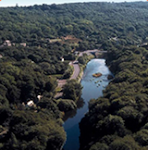Wednesday 10th September 2025, Wintles
Bishop’s Castle was the destination for this outing. To an area of community managed space at The Wintles. This site is woodland that was planted about 20 years ago on former pasture to the north of Bishop’s Castle, together with large areas of grassland, an orchard and some allotments.
Knowing that many apples trees have had a bumper crop this year it was not too surprising to note that the orchard at this site needed a skip to deal with the apples.
Having met up and kitted ourselves out, we moved to an area where a moth trap had been running overnight to check the catch.
In amongst a good collection of moths was a Feathered Rustic, Tholera decimalis.
There is only a certain number of people that can mill around a moth trap so the rest of us checked out what else we could find in the area around about.
Tapping a conifer dislodged this tiny Bristly Ladybird, Rhyzobius lophanthae.
Moth trap emptied and moths recorded, we moved on to the main site, to a small patch of grassland and young trees with good hedgerows nearby.
An early find as a result of beating the vegetation in this area were two 22-spot ladybirds, Psyllobora vigintiduopunctata.
This was followed by a harvestman, Dicranopalpus ramosus agg., noticed in the tray amongst the results of a suction sample.
Inspecting a young oak we found that it was host to a number of galls caused by different species. In fact, it proved to be a bumper day for plant galls. 25 species were found, 15 on oak and 10 on other plants.
These included a first record for Shropshire of the gall caused by the asexual generation of the gall wasp Andricus glandulae.
The second county record of a Striped Pea Gall Gall, caused by the asexual generation of the gall wasp Cynips longiventris.
And the fourth record of the gall caused by the asexual generation of the gall wasp Andricus grossulariae.
We also noted the presence of the gall on Walnut caused by the mite Aceria erinea.
A galling day! But not in the sense that we would normally use the term “galling” – far from it.
We moved on to one of the two sets of allotments. Gathering around a small pool in the top corner, we ventured forth from there to see what could be found making a living in the vegetation.
And here are a few of the species that were found in this area.
A Garden Spider, Araneus diadematus.
A large plant bug, Pantilius tunicatus.
A vacated leaf mine characteristic of the moth Stigmella tityrella.
Mines in leaves arise when an insect larva eats it way through the tissue of a leaf. They are often distinctive. The species of insect that caused it can frequently be determined from the plant it has mined, the pattern of the mine and the way it has distributed its frass (excrement) within the mine.
A juvenile Nurseryweb Spider, Pisaura mirabilis.
A Small Magpie moth, Anania hortulata, larva on a nettle leaf.
 |
| Photograph: David Williams |
A larva of a Ruby Tiger moth, Phragmatobia fuliginosa.
Lunchtime.
As it was warm and dry I was about to declare lunch to be taken by the pool, when…
It rained!
And it was not a short light passing shower.
It was a downpour.
We made hastily for the polytunnel at the opposite end of the allotment area.
Finding places to sit we settled down to eat our lunches…
The polytunnel housed its own wildlife.
A larva of a Small White butterfly, Pieris rapae.
A pupa of a Large White butterfly, Pieris brassicae.
A parasitised larva of a Large White butterfly caused by a parasitic wasp, Cotesia glomerata.
And finally a parasitic wasp that is not Cotesia glomerata but another species which has not been identified as yet (and may never be).
The rain stopped and we made our way out of the polytunnel, through the allotment to the far end, then up a short incline to an area known as the Motte.
Despite its name it is not an ancient monument, but a feature created far more recently.
It commands a great view.
We spent the rest of the day on and around the edge of this feature. In amongst our findings were a ground beetle, Nebria brevicollis.
And a Hawthorn Shieldbug, Acanthosoma haemorrhoidale.
Our time was up.
We returned to the cars and went home after another enjoyable day on this site.
Weevil of the Week.
Coelositona cambricus.
My thanks to the owners for allowing us to visit and do what we enjoy doing, and the cake. My immense gratitude to the photographers for their excellent images.


















































No comments:
Post a Comment
Please feel free to comment on this post...